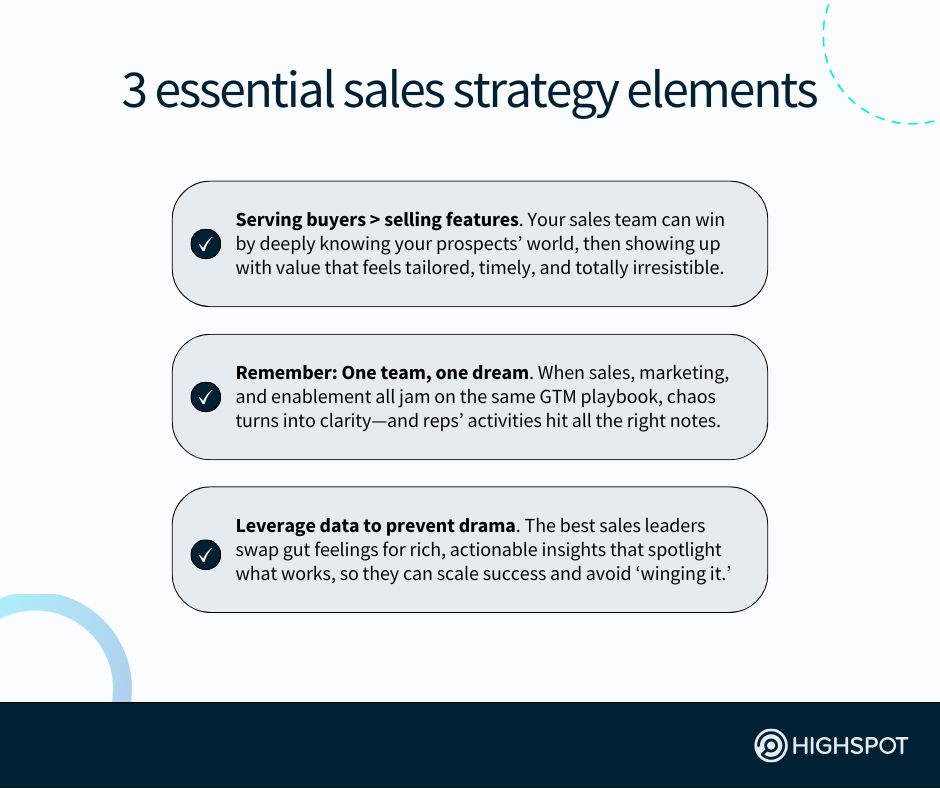Key Takeaways
- A winning sales strategy for your B2B business connects your reps’ hustle to high-impact results—meaning your sellers aren’t just working hard, but also working smart (and actually closing deals).
- Spray and pray is dead. Modern sales strategies mix smart targeting, tailored plays, and seller-ready content that meets buyers where they are. No noise. Just precision that drives pipeline.
- Tactics are temporary. Strategy is your edge. Align go-to-market (GTM) teams, activate your message, and scale what works—because hope isn’t a growth plan, and chaos deters reps from hitting quota.
Sales strategy advice is everywhere, but let’s be real: Most of it is either outdated, overly simplified, or written by people who haven’t closed a deal since dial-up.
That’s why we put together this 2026 edition of our playbook for you and other B2B go-to-market leaders: to give you fresh, field-tested sales strategy examples and ideas that actually work for your sales team—not just in theory, but in practice.
You know the basics of building a plan, managing the sales process, and aligning GTM teams. What you’ll find here goes well beyond foundation-building advice.
Our guide offers real-world tactics and techniques that can help you take your company’s sales strategy to the next level so your GTM teams can collectively:
- Drive consistent execution across sales, marketing, and enablement activities
- Scale the sales messaging and content that work and ditch what doesn’t
- Move the needle on metrics that matter: win rates, deal velocity, and more
TL;DR: If you’ve ever wondered what it takes to go from a good sales strategy to a great sales strategy that drives revenue and inspires your team, you’re in the right place. Let’s dive into a few dozen ideas that work in the real world—no fluff, just fuel.

What is a sales strategy?
A sales strategy helps your reps, account executives, customer success teams, and other sellers position your company, products, and services to attract and secure prospective customers and retain the business of existing customers.
Winning sales strategies include clear directives for sales, enablement, and marketing teams on how to build sales processes, adopt sales methodologies, develop product positioning and messaging, and conduct market and competitive analysis to close more deals and upsell, cross-sell, and renew customers.
Building lasting customer relationships is at the heart of any sales strategy.
Open, ongoing communication between your sales teams and key decision-makers and stakeholders at target accounts can significantly impact brand loyalty and customer satisfaction and dictate the success of your sales strategy plan.
Whether you’re a mid-sized business or enterprise organisation, your company’s sales strategy must be revisited and revised regularly to adapt to recent industry trends, newly surfaced or changed business goals, and shifting customer needs.
| Sales strategy component | Why it matters | Relevant sales KPIs |
|---|---|---|
| Ongoing CRM hygiene and automation | – Keeps sales rep workflows efficient and data reliable – Enables timely, relevant customer engagement | – Activity logged – Follow-up rate – Contact frequency |
| Unified go-to-market campaign execution | – Aligns marketing and sales to drive pipeline – Reduces duplication and boosts buyer experience | – Campaign-influenced pipeline – Engagement rate – Win rate |
| Real-time rep coaching and feedback | – Drives skill development and consistency at scale – Helps sales team members improve where it counts | – Coaching completion – Skills progression – Quota attainment |
| Lead-to-opportunity conversion process | – Converts more leads by refining handoffs – Ensures reps focus on qualified opportunities | – Lead conversion rate – Time-to-opportunity – MQL-to-SQL ratio |
| Just-in-time sales enablement content | – Equips reps with the right assets and messaging fast – Improves both meeting prep and buyer interactions | – Content usage rate – Time-to-pitch – Content-influenced revenue |
| AI-powered sales pipeline forecasting | – Enables more accurate revenue planning – Helps sales leaders act early to course-correct | – Forecast accuracy – Pipeline coverage ratio – Deal slippage |
| Role-based rep onboarding and training | – Speeds up new-sales-hire ramp time and readiness – Standardises knowledge and improves retention | – Time-to-productivity – Certification rate – Lesson completion |
| Full strategic GTM initiative adoption | – Ensures go-to-market plans stick in sales and marketing – Helps measure programme success beyond delivery | – Initiative adoption rate – Sales play usage – Programme-influenced revenue |
What winning sales strategies look like
It goes without saying: No two will look exactly alike. But the most successful sales strategies today led by B2B sales leaders like your are ones that always:
Leverage sales performance data to land on revenue targets
Treat data not just as a dashboard, but as a daily advantage for your GTM teams.
You can’t hit revenue targets by guessing or relying on stale KPIs. Establishing an effective sales strategy requires real-time visibility into key sales metrics, paired with insights from each rep’s sales pipeline. That means you need a sales analytics solution that offers actionable, AI-powered insights all the time.
That’s how you spot what’s working, fix what isn’t, and course-correct as needed.
Sales managers are leaning into this shift, using sales conversation data, activity tracking, and calls analysis to coach smarter and forecast faster.
The best sales teams today are using these insights to align sales and other go-to-market teams on shared goals and coordinated motions.
Factor in deal velocity, conversion rates, and engagement benchmarks, and you’ll develop a sales plan that’s more ‘executable’ than aspirational.
And when you’re factoring in accurate, up-to-date lead and customer data to identify sales trends, you’re building momentum in addition to hitting quota.
Prioritise customer relationship management improvements
Build loyalty, not just pipelines. It’s not enough to just close deals today. You also need to keep prospective customers engaged and coming back.
That’s why B2B sales teams like yours are rethinking their CRM systems. They no longer view them as just a database. They use them as the foundation for revenue growth.
An effective customer relationship management strategy means having your entire sales department capitalise on robust buyer insights to discern what activities and outreach leads to sales success. It also means reps working with your marketing team to drive relevant, timely outreach to potential customers.
The content you serve, the timing of your touchpoints, even the tone of your emails: They all influence your sales enablement and marketing strategy.
And when your CRM is tightly integrated with other business-critical systems, like your sales enablement platform, it unlocks serious gains in efficiency and insight.
Your CRM also streamlines sales cycle management, helping sales managers and reps zero in on the accounts that matter most. If you’re not prioritising the systems and workflows that shape customer relationships, you’re leaving revenue on the table.
(Not to mention missing opportunities to serve your target audience better.)
Empower sales professionals to meet quotas and thrive daily
Treat your reps like elite performers, not task machines.
Give them the world-class tools, comprehensive training, and time they need to sell smarter, and create a culture that celebrates the daily grind, not just the quarterly number.
Establishing an effective sales strategy requires more than a list of goals.
You need a game plan that builds confidence, hones skill, and makes the work easier—especially for new hires or those in complex verticals.
Your managers can support this by leaning on sales enablement tools that serve up just-in-time content, battle cards, and coaching tied to live calls and real scenarios.
By analysing sales conversation data and key sales metrics, you’ll uncover patterns that drive real behaviour change. And when you empower reps to act on insights from each rep’s sales pipeline, you get better decisions in every moment that matters.
The best sales teams today don’t just survive the day-to-day. They thrive in it.
Use best-in-class sales tools to plan, execute, and optimise
Every sales team member should be able to use every tool in your sales tech stack like a teammate. If your solutions don’t ‘speak’ with one another and help reps move faster, show up smarter, and close more, it’s time for an upgrade.
Today’s smartest revenue orgs are investing in platforms that combine content, training, coaching, and analytics—so reps get what they need, when they need it.
That’s how you build a strategic sales plan that actually works in the real world. And when tools are chosen strategically—with the ability to align sales and other GTM teams on key initiatives and campaigns—you get speed and scale.
Sales managers love it. Reps live in it. And revenue leaders get real-time visibility into what’s moving deals thanks to robust sales intelligence in your enablement analytics tool.
Pair that with factoring in lead and customer data to identify sales trends, and suddenly you’re making smarter, analytical decisions, not broad assumptions.
Bonus: The right sales tools also deepen your understanding of your target audience—so you can build messaging that lands in every stage of the sales cycle.
Watch this video to learn why sales training programmes are only effective if they actually stick—and how, when they go wrong (and rely on the wrong tools), they can overwhelm your reps.
Your sales strategy’s business impact
An effective sales strategy is like giving your sellers the best roadmap. It will lead to better team performance, precise targeting, and more closed deals.
Specifically, a dedicated, data-driven sales strategy is one that:
- Features consistent messaging with buyer engagement: Imagine everyone in your team speaking the same language when talking to customers. A solid sales strategy ensures that happens. It keeps all your communications consistent, which not only builds trust but also strengthens your brand identity.
- Enables all sales reps to maximise their lead opportunities: With a clear strategy, team members can spot opportunities faster and prioritise more accurately, tailoring their conversations to turn prospects into happy customers.
- Improves resource allocation for every go-to-market team: A good strategy keeps your sales team from wasting time guessing. By focusing your time and money where it counts, you optimise team efforts and boost your return on investment.
- Proactively identifies and addresses problems as they arise: Planning ahead with a sales strategy keeps you prepared. By anticipating problems before they pop up, you’re not stuck fixing messes but smoothly steering clear of potential setbacks.
- Is targeted to ensure only high-value prospects are engaged: Knowing your ideal customers and understanding their needs and industries helps you add more value during sales calls. A robust sales strategy allows your sales reps to customise their sales pitch to resonate perfectly with each customer, making their approach more engaging.
Bottom line: A well-planned, highly effective sales strategy sets your entire revenue organisation up for growth and ensures your business thrives in the long run.
It’s about smarter planning today so you can be successful (read: repeat sales processes that work consistently so you can scale closed-won) tomorrow.
The 2 common types of sales strategies
You’re well-versed in inbound and outbound sales strategies. (And you understand that modern sales is really about ‘allbound.’) That said, it’s worth covering the pros and cons of both approaches as it relates to your 2026 sales strategy.
1) Inbound sales strategy
Your inbound sales strategy used to be the darling of scalable, low-cost lead generation. Just set up a website, produce and publish content frequently, host informational and product-centric webinars, and wait for MQLs to roll in.
But in 2026, the game’s changed.
Buyers are saturated. The noise from prospective vendors in an increasingly crowded market is growing louder. Potential customers are downloading fewer eBooks, ghosting reps more, and making brands work to earn their trust, not just their clicks.
Inbound absolutely still plays a pivotal role—just not as a standalone engine.
It’s most effective when tightly connected with outbound motions, especially when your marketing team can pinpoint which downloads, content views, webinar registrations and attendance, or site behaviours actually signal intent.
Put another way? Passing MQLs over to reps because they met a lead-score threshold doesn’t cut it anymore. High-performing sales teams use behavioural data to gauge who’s ready, then strategically engage them across channels.
Your inbound selling strategy now needs to be proactive, not passive.
Think less “wait and nurture” and more “score, route, and act—fast.” Otherwise, you’re just educating your competitors’ pipeline with little to no payoff (see: customer conversion).
| Pros of an inbound sales strategy | Cons of an inbound sales strategy |
|---|---|
| Scales efficiently across audiences by allowing your team to build long-term demand at a low cost, while keeping programmes running 24/7 in the background | Can result in low-quality leads when content attracts browsers rather than buyers, creating a burden on reps to sift through noise and wasted pipeline entries |
| Warms up buyers over time by building familiarity, credibility, and trust through repeated exposure to thought leadership, content offers, and nurturing programmes | Long ramp to revenue, since content-driven nurture takes months (or years) to mature, and competitors may benefit from your awareness-building efforts |
| Supports brand-building via thought leadership and domain expertise, creating market authority that pays dividends with pipeline generation and deal acceleration | Requires a strong content marketing infrastructure, from skilled writers to design resources, which can strain budgets and timelines if not strategically aligned |
| Easy to track through analytics across site behaviour, webinars, and downloads, allowing granular insights that can inform sales conversations and campaigns | High volume doesn’t mean high intent, and without advanced scoring models, you risk flooding sales representatives with MQLs that don’t convert into real opportunities |
| Great for mid-funnel deal acceleration when leads actively search for solutions, as inbound assets reinforce credibility and give buyers confidence to act | Hard to prioritise leads without scoring, routing, and automation, leaving sales managers frustrated by wasted time and misaligned resource allocation |
2) Outbound sales strategy
Your outbound sales strategy, meanwhile, has also evolved—dramatically.
Years ago, outbound meant spray-and-pray cold calls, untargeted cold emails, and generic sequences blasted out to massive lists. It worked … until it didn’t.
Buyers wised up. Spam filters got smarter. And the definition of “personalisation” had to go from “Hi {{FirstName}}” to “Here’s why this actually matters to you.”
In 2026, outbound is more precise, bespoke, and—when done right—powerful than ever.
Instead of flooding inboxes, the best sales teams use LinkedIn and buyer intent data to contact prospects who align with your ICP, using relevant triggers to engage in ways that feel helpful, not harassing.
Cold emails still work, but only if you earn the reply.
Cold calls? Still viable—but only if they’re timely, contextual, and valuable.
Outbound sales has become (much) less about volume and more about orchestrated, high-impact plays as part of your account-based selling approach run by your sales department and marketing team. The result? Less noise, more meetings.
| Pros of an outbound sales strategy | Cons of an outbound sales strategy |
|---|---|
| Offers immediate control and targeting, enabling reps to select accounts, ID key stakeholders, and launch outreach programmes without waiting for inbound interest | Can feel intrusive to some B2B buyers if messages are generic, mistimed, or irrelevant, leading to reputational risk and potential brand damage |
| Helps penetrate strategic accounts where inbound signals are weak, by empowering reps to proactively contact prospects who align with your ideal customer profile | Labor-intensive, since modern outbound requires deep research, advanced personalisation, and multiple coordinated touchpoints for meaningful engagement |
| Better alignment with ABM campaigns, as reps can work in tandem with your marketing team to synchronise content delivery, direct outreach, and buyer engagement plays | Reps need higher skill to succeed because buyers demand relevance and value from the first interaction, which requires training, data, and constant iteration |
| Can quickly test positioning and messaging by running targeted sequences, measuring response rates, and feeding learnings back to product marketing and enablement teams | Outbound that feels spammy or aggressive can turn off leads entirely, damaging trust with prospective customers before sales conversations even begin with them |
| Scales with tech and automation when used wisely, allowing teams to expand outreach across LinkedIn, cold emails, and calls while still maintaining a personalised touch | Deliverability issues with bad outreach practices, including blacklisted domains or filtered messages, which can undermine even the strongest outbound programmes |
Balancing the account-based selling approaches
Typically, a healthy mix of inbound and outbound strategies works best.
For example, a software company might use inbound strategies like SEO (and now AEO) blogs, how-to guides, and industry-related webinars to attract interest.
At the same time, they might also use outbound sales activities like cold calling or
LinkedIn messages to reach out directly to targeted business decision-makers.
This blend allows you to cover all bases by nurturing organic relationships and reaching out to those who may not know they have a problem or need a solution.
5 types of proven sales methodologies that can fuel your B2B sales strategy
In addition to balancing inbound and outbound selling, your GTM leadership must also adopt the most appropriate sales methodology. Picking a sales methodology isn’t just a box to check—it’s the engine under your revenue hood.
- Choose the right one, and you’ll give your reps a repeatable rhythm that builds confidence, moves deals forward at the desired pace, and fuels revenue growth.
- Pick the wrong one, and, suddenly, you’ve got friction everywhere: stalled cycles, confused reps, and a sales plan that looks better on paper than in practice.
In short, you need to adopt a sales methodology that fits your team, aligns with your business model and market, and—if you’re an enterprise with an international presence—can apply to different types of sales strategies implemented globally.
Here are a handful of proven frameworks we’ve seen drive down the average sales cycle length and accelerate pipeline for B2B organisations across industries.
1. Value-based selling
Value selling has become the cornerstone of any good sales strategy because buyers care less about features and more about outcomes. Your sales professionals need to anchor every pitch to measurable business impact.
This approach entails showing potential customers how you solve their problems better than anyone else. Done right, it builds trust and accelerates decisions, especially with target customers under pressure to justify every spend.
2. Consultative selling
Consultative selling puts curiosity at the centre of the entire sales process. Instead of pushing a product, your sales development reps ask sharp questions, uncover real challenges, and co-create solutions alongside buyers.
This makes leads feel heard—and when potential customers feel understood, they’re far more likely to engage deeply. The best reps master sales messaging that demonstrates empathy while steering the conversation toward value.
Consultative sales is less “always be closing” and more “always be helping.”
In this video, our team explains how each distinct sales methodology brings a different lens to the selling experience—and how choosing the right one directly impacts your revenue growth.
3. SPIN selling
SPIN selling still works wonders when your team knows how to use it with nuance. “Situation, Problem, Implication, Need-payoff” is a framework that forces your sales professionals to uncover pain and make its impact undeniable.
The magic comes when outbound sales teams use SPIN to guide target customers through layered discovery, surfacing urgency instead of manufacturing it.
The ability to gauge problems prospects have, as reps engage them at various stages of the sales funnel, then link them directly to potential outcomes is gold.
4. Solution selling
Solution selling remains a powerful tactic, but only when it’s used with precision.
Buyers no longer want cookie-cutter decks; they expect tailored insights that fit their world. That means aligning every recommendation to the needs of your target market while positioning your offer as the missing piece of the puzzle.
Your company’s sales professionals need to frame your product not as “the thing we sell,” but rather as the exact solution that accelerates growth. When executed well, a solution-sales approach transforms conversations into commitments.
5. Challenger selling
Challenger selling works best when buyers are already educated. Instead of just responding to needs, reps take control. More to the point, they teach prospects, tailor messaging to each one, and sometimes provoke new ways of thinking.
For your account-based selling efforts, this is especially potent, as it helps reps cut through noise and creates urgency with high-value accounts. Potential customers respect confidence paired with insight, and modern outbound sales teams that challenge assumptions can win credibility with leads very fast.
| Industry | Sales strategy examples | ROI of GTM enablement upgrades |
|---|---|---|
| Healthcare & Life Sciences | Aetna aimed to simplify sales complexity across a dispersed workforce while improving collaboration between sales and marketing. Highspot enabled centralised content governance, enhanced findability, and visibility into content performance—breaking down silos and driving unified discussions around high‑impact collateral. | – 62% improvement in sales content governance – 83% improvement in enablement content discoverability |
| Manufacturing | Siemens sought to standardise content across a global sales force and embed role‑based guidance. Highspot centralised enablement, unified Sales Plays, and integrated in‑workflow support—aligning sellers globally and equipping them with consistent, relevant materials when they needed them. | – 100+% of annual revenue growth targets exceeded – 72% of reps completed sales certification programmes |
| Financial Services | Osaic needed to onboard advisors efficiently and equip them to articulate complex product offerings. With Highspot, they operationalised tailored training by product and persona, standardised content delivery, and embedded guidance—enabling advisors to ramp faster and stay aligned with GTM strategy. | – 95% increase in sales quota attainment for reps – 74% improvement in deal win rate |
| Professional Services | Office Depot wanted to modernise sales engagement for an enterprise, hybrid workforce. Highspot enabled them to launch Digital Sales Rooms, embed just‑in‑workflow guidance, and personalise buyer engagement—setting up sellers to drive more consistent, relevant conversations with prospects. | – 86% improvement in enablement content discoverability – 72% improvement in sales content governance |
| Consumer Packaged Goods | Acosta used Highspot to drive consistent execution and product knowledge across a distributed retail execution team. Through integrated training, coaching, and content, reps were better prepared for key customer conversations. The result? A 25% increase in rep confidence and a 35% increase in training course completion rates. | – 70% increase in sales quota attainment for reps – 50% improvement in deal win rate |
| Media | Oxford University Press was shifting toward digital‑first and hybrid selling models. They used Highspot to centralise sales content, unify messaging, and streamline playbooks—improving content access, alignment across channels, and execution speed in their sales motions. | – 23% increase in buyer engagement across funnel – 81% adoption of enablement platform’s sales pitch capabilities |
Essential elements of modern sales strategies that help drive results
Spoiler alert (except not really): There is no one-size-fits-all sales approach.
Whether you’ve been selling for decades or you’re a new sales leader, implementing the right tactics can vastly improve your team’s performance and bottom line.
The tried-and-true techniques employed in great sales strategies include:
Researching and qualifying prospects intelligently
Your prospects must meet qualification criteria (budget, timeline, company size, industry, or other parameters) before your sales reps engage with them for the first time. You want your sales efforts to be targeted and impactful, not wasted on uninterested leads you can’t help.
A recent Gartner survey found that although 34% of marketing-qualified leads (MQLs) convert to sales-accepted leads (SALs), only 47% of these SALs evolve into sales-qualified leads (SQLs), with just over half ultimately closing as won deals. This underscores the need for marketing and sales qualification processes, which can accelerate conversion.
Balancing inbound calls with cold calling leads
Inbound leads are ‘warmer.’ They have come to you without direct sales outreach.
This doesn’t mean they are ready to buy, but prioritising them can result in higher conversion rates because the prospect has already shown interest in your brand’s product or service.
Cold calling is a necessary tool in sales that can open doors to new opportunities despite its reputation. Interestingly, recent RAIN Group research found that 82% of buyers say they accept meetings, at least sometimes, with sellers who reach out to them proactively.
Always start your cold call with a concise and attention-grabbing introduction that highlights the value you offer. Clearly articulate how your product or service can fulfil the prospect’s needs or solve their pain points.
The last thing you want to happen is to get caught off guard with objections, so be sure to prepare responses that address concerns without being defensive.
Proactively engage your ICP via social selling
Social selling has become a must-have branding and sales tool. It helps strengthen your brand, expand your reach, and attract high-quality leads.
LinkedIn is a natural destination for sales reps to build relationships with prospects and position your business as a trusted expert. A recent LinkedIn report found 78% of salespeople who use social media perform better than their peers.
Paying attention to lead and customer feedback
Active listening—and reacting to questions, comments, and concerns quickly—is key to both securing new business and keeping your customers long-term.
Asking for feedback through surveys or other methods and adjusting your product or service accordingly shows you’re dedicated to customer satisfaction, leading to better quality solutions and services that attract new customers.
Companies that adopt a customer feedback process (owned by CSMs) often see lower churn rates and more opportunities for upselling and cross-selling.
Offering free trials and providing custom demos
No-obligation trials are one of the most effective sales strategies to attract new customers. They allow prospects to experience your product without risk. If you’re a SaaS firm, a free trial can be guided by your team or self-serve, depending on product complexity.
Also, showcasing your product’s value and functionality is incredibly persuasive, especially when you show how the solution solves a prospect’s problem. Demos must be available for complex or high-value products, in particular.
Many customers believe a product demo best assists them with purchase decisions.
The Highspot team discusses why sales and marketing alignment doesn’t just happen overnight. It takes intention, shared KPIs, and valuable and accessible enablement content for reps.
How to build a successful sales strategy
Now, you’re ready to plan. It’s time to build a sales strategy that works.
Start by setting clear sales goals and then work with sales leaders to identify what your sales team needs to do to reach those lofty (but reachable) revenue targets.
This typically involves:
- Understanding your target customers and their unique needs
- Developing messaging and communication approaches
- Equipping your team with the right tools and resources
- Implementing metrics to measure progress and success
Let’s outline the critical steps that go into creating a sales strategy that provides your sales team with the knowledge, tools, and guidance to find and retain customers:
Invest in the best sales technologies for your reps
The right technology stack, from sales forecasting tools and data analytics to CRM systems and sales enablement platforms, can streamline operations and provide valuable insights.
Today’s teams rely on sales enablement technology to better align marketing and sales.
A sales enablement platform creates a single source of truth for marketing content, sales plays, and templates. This allows reps to quickly find, customise, and pitch approved assets.
Some enablement platforms are even integrating AI capabilities to empower sellers further in conversations with leads. For example, Highspot reviews reps’ emails and call transcripts to provide real-time coaching on message consistency, talk ratios, and areas for improvement.
Salesforce research shows 84% of businesses that use AI for sales have seen an increase in closed deals by improving and accelerating customer interactions.
While powerful, these solutions’ success ultimately depends on a solid sales process and strategy. Bring marketing into the strategy development phase and provide ongoing feedback as you execute to boost your strategy’s impact.
Establish sales goals that map up to business goals
Start defining clear revenue and sales performance goals aligning with company objectives.
Once you have these goals, you can determine how your team will reach them and measure success along the way. Remember: You need SMART sales goals—that is, ones that are:
- Specific: Your team targets a specific percentage increase in total revenue generated.
- Measurable: Revenue numbers can be easily tracked and measured by GTM leaders.
- Achievable: The revenue goal is ambitious yet attainable with the right approach.
- Relevant: The goals you set align with North Star business objectives for the year.
- Time-bound: Each goal has a clear deadline for the year and milestones to achieve.
Goals are a collaborative business effort. To set these goals, sales leaders should work with cross-departmental executives, managers, and other stakeholders.
Evaluate past performance metrics, too. Ask questions like:
- “How much did my sales team actually sell last year?”
- “Which clients generated the most revenue?”
- “What facets of the sales funnel likely need fixing?”
- “Do we need to reconsider our target market?”
- “What’s the next logical step to increase sales?”
- “Which assets will my team need to support growth?”
Answering these will help map a path from your current position to your desired outcomes.
Know your target audience and customer base
Markets are constantly evolving—new competitors emerge, and customer preferences shift.
That’s why research can’t be a one-off thing. Stay updated to continuously refine your strategy, meet changing demands, and maintain that competitive edge.
One of the most basic pieces of knowledge your business needs is who will buy what you’re selling. To develop a sales strategy, you must understand your target customers, including the nuances of their behaviours and preferences.
As noted, consider revamping your ideal customer profile and buyer personas.
The feedback you collect from existing customers and market research you conduct (either on your own with competitive intelligence tools or with the aid of a third party) can offer actionable insights to help you pivot your sales strategy.
Align the sales strategy with your GTM initiatives
What core message will your sales reps lead with when pitching your product? Work closely with product marketing to ensure your sales team can easily access buyer personas, messaging, and accurate pricing.
Make these foundational resources available, continuously refine them, and ensure sales reps know how to use them at each stage of your typical sales process, including and especially solution and consultative selling scenarios.
To avoid working in silos, closely align your sales strategy with marketing efforts.
Regularly review and coordinate so that marketing activities—from content creation to lead generation—are designed to support and amplify your sales targets.
Onboarding B2B sales enablement technology can help synchronise these efforts. With it, your reps can easily access marketing-approved resources. This alignment is key for attracting and converting new leads that align closely with your ICP.
Continually train, coach, and guide your sales team
Successful sales teams are well-educated about your product, market, and competition.
Enrolling your sellers in dedicated sales training programmes with adaptive learning paths and offering AI sales coaching can help them thrive day in and day out.
These programmes should include practical exercises, access to enablement materials, and continuous learning opportunities to keep your team sharp and prepared.
Being an experienced rep is one thing. Understanding pragmatic product messaging, target markets, value props, ICPs, and competitive advantages is another.
Make sure your sales training includes:
- Structured onboarding and ramp-up for every new hire
- Overview of your sales tools and how to use all of them
- Modules on how to access sales enablement materials
- Best-practice checklists and guides for sales pitches
- Just-in-time training and guidance to aid reps’ sales calls
- On-demand learning videos for your sales methodologies
- Routine rep practice sessions and performance evaluation
“Real, applicable, successful sales learning doesn’t materialise from a sweeping, role-agnostic traditional LMS approach,” Highspot’s Why Sales Needs its Own Training Tool eBook explains. “Instead, sellers need training that dovetails with their daily workflow helping them execute consistently in their roles.”
Translation: You need a GTM enablement platform with AI-powered sales training and coaching capabilities baked in to onboard, educate, and up-level reps efficiently.




